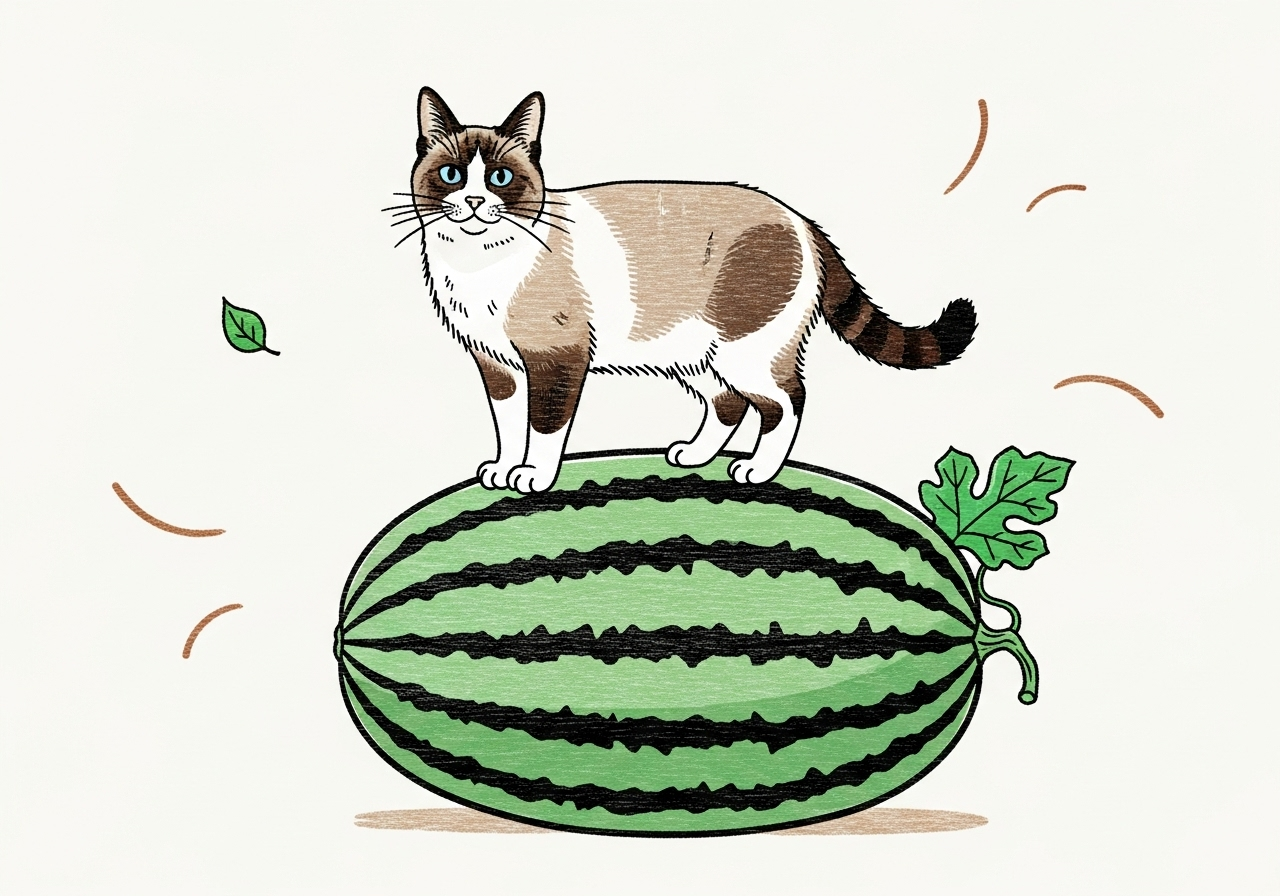Can cats eat watermelon?

Watermelon can be a hydrating, non-toxic treat for cats, but there are crucial safety rules. This guide explains the benefits of its high water content, the serious dangers of the seeds and rind, and how to safely prepare a tiny piece for your cat on a hot summer day.
Can Cats Eat Watermelon? A Hydrating Treat with Hidden Dangers
On a sweltering summer day, there's nothing more refreshing than a cool slice of watermelon. As you enjoy this juicy treat, your cat might show some interest, but is it safe to share? The answer is a qualified yes. The pink flesh of a watermelon is non-toxic to cats and can be a hydrating treat in very small amounts. However, the seeds and rind pose significant dangers, making proper preparation absolutely essential. Before you let your cat have a taste, it's vital to understand the benefits, the risks, and the rules.
A Hydrating Treat: The Main Benefit of Watermelon
The primary advantage of watermelon for a cat lies in its name: water. Composed of about 92% water, a small piece of watermelon can be a good source of hydration. Many domestic cats don't drink enough water, which can contribute to urinary tract issues. Offering a tiny, watery treat like watermelon on occasion can be a fun way to help supplement their fluid intake, especially in warmer weather. Watermelon also contains some vitamins like A and C, but as cats produce their own vitamin C and get all necessary vitamins from their balanced diet, this is not a significant benefit. The real, albeit minor, perk is hydration.
The Obligate Carnivore Reality Check
As always, we must view any non-meat food through the lens of a cat's biology. Cats are obligate carnivores, meaning their bodies are designed to get nutrients from animal sources. They have no nutritional requirement for fruit. Their interest in watermelon is likely due to its high moisture content and novel texture, not a craving for its sweet taste (which they cannot perceive). While a small amount won't harm them, it should never replace any part of their regular, meat-based diet.
The Dangers Lurking in Watermelon: Seeds and Rind
While the flesh is safe, the other parts of the watermelon are hazardous and must be completely avoided.
- Watermelon Seeds: The seeds are a major risk for two reasons. First, they can pose a serious choking hazard or cause an intestinal blockage if swallowed, which is a veterinary emergency. Second, seeds contain trace amounts of cyanide, a toxin that is released when the seed is chewed or broken. While a single seed is unlikely to cause poisoning, it's a risk not worth taking. Both black and white seeds should be removed.
- The Rind: The tough, green rind is indigestible for cats. If a cat were to chew on and swallow pieces of the rind, it could lead to severe gastrointestinal upset or, more dangerously, a life-threatening intestinal obstruction. Never allow your cat to chew on the rind.
Other Potential Risks to Consider
Beyond the seeds and rind, there are a couple of other factors to keep in mind:
- High Sugar Content: Watermelon is naturally high in sugar. For a small carnivorous animal, this sugar can lead to an upset stomach, diarrhea, or gas. Over the long term, feeding sugary treats can contribute to obesity and increase the risk of developing feline diabetes.
- Allergic Reactions: Though rare, it's possible for a cat to have an allergic reaction to any new food. Signs might include itching, swelling, or digestive upset.
How to Safely Share Watermelon with Your Cat
If you want to offer this hydrating treat safely, follow these steps without exception:
- Choose Seedless if Possible: Starting with a seedless watermelon makes the process much safer and easier.
- Remove ALL Seeds and Rind: This is the most important rule. Meticulously pick out every single seed, black or white. Cut the pink flesh completely away from the green and white rind. Your cat should only ever be offered the pure, seed-free flesh.
- Cut into Tiny Pieces: A small, bite-sized cube (about a half-inch) is more than enough for a single serving. This prevents choking and keeps the sugar intake to a minimum.
- Serve as an Occasional Treat: This is not a daily snack. Think of it as a special, refreshing treat on a particularly hot day, offered no more than once or twice a week in summer.
- Monitor Your Cat: After the first time, watch for any signs of an upset stomach. If your cat has diarrhea, it's a sign their system can't handle it, and you should not offer it again.
Conclusion: A Refreshing Novelty with Strict Rules
In summary, the seedless, rindless flesh of a watermelon is a safe and hydrating treat you can offer your cat in tiny, infrequent portions. Its high water content is a nice bonus, but the risks associated with the seeds and rind are serious and must be avoided. Remember that it's a nutritionally unnecessary novelty. The cornerstone of your cat's health will always be a complete and balanced diet formulated for their carnivorous needs.


